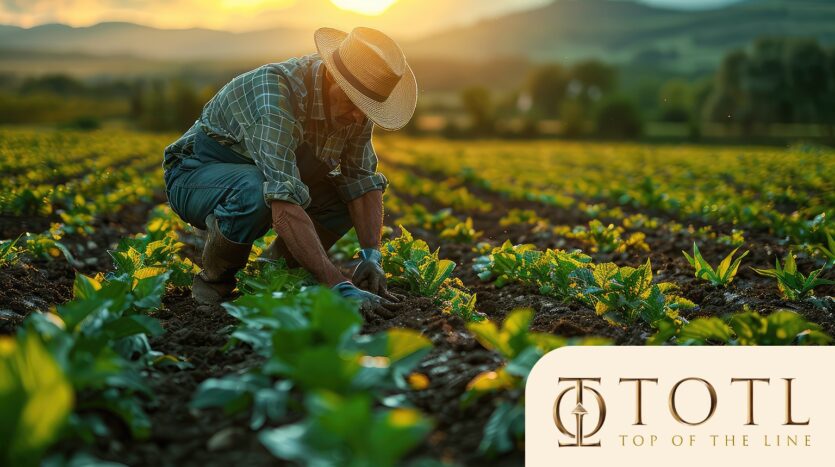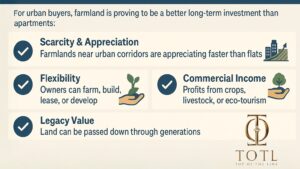Why Agrofarming Is India’s Next Big Land Revolution
Agrofarming in India 2025 is redefining how land remains India’s most trusted asset.. From farmers cultivating ancestral plots to urban families investing in real estate, owning land has always symbolised wealth, security, and legacy. But in 2025, land ownership is taking on a new meaning with the rise of Agrofarming in India.
Agrofarming combines traditional farming practices with modern lifestyles. It allows people who don’t want to leave the comfort of city life to become farmland owners still — growing crops, building eco-retreats, and even earning commercial profits.
In regions like Goa and Maharashtra, collaborative agrofarming estates are emerging where groups of like-minded families buy or lease 100–200 acres of land together. The land is then managed by professionals, while owners take home the organic yield. This model is attracting NRIs, HNIs, and eco-conscious city dwellers, making agrofarming one of the fastest-growing farmland investment trends in India.
This guide explores everything you need to know about agrofarming in India, farmland investment, and the latest farming trends in 2025.
What is Agrofarming?
Agrofarming refers to owning and managing farmland for cultivation, self-sustenance, or commercial profit, often with the support of professional management services.
Unlike traditional farming, agrofarming is designed for people who:
- Live in cities but want farming benefits.
- Wish to consume their own organic food.
- Are looking for a secure land investment with long-term ROI.
- Value sustainability and eco-living.
Agrofarming is not just about food — it’s about wealth, lifestyle, and independence.
Types of Agrofarming Land in India
Agrofarming land can be used in multiple ways, making it one of the most versatile forms of real estate:
- Managed Farmlands – Estates managed by professionals where owners share costs and yields.
- Organic Farmlands – Dedicated to chemical-free produce for health-conscious families.
- Farmhouse Lands – Agricultural plots developed into luxury retreats with cottages, solar energy, and rainwater harvesting.
- Agro-Tourism Estates – Farms converted into wellness resorts, eco-stays, or weekend getaways.
- Commercial Farmlands – Used for high-demand crops, spices, or horticulture for market profits.
Latest Farming Trends in India (2025)
India’s agriculture sector is transforming at record speed. Here are the key agrofarming and farming trends shaping 2025:
Trials in Varanasi have shown how drones are now being used for crop spraying and monitoring, reducing costs and increasing efficiency.
AI models are helping farmers in Maharashtra’s sugarcane industry predict yields and improve crop productivity.
Urban investors are exploring hydroponics and aeroponics systems that grow crops without soil, making farming possible even in semi-urban spaces.
India’s organic food market is growing 20–25% annually, supported by rising domestic demand and exports .
Collaborative Farming Communities
Groups of urban professionals are pooling land to create community-driven estates — a trend that is booming in Goa & Maharashtra.
Agro-Tourism
Agro-tourism farms are becoming weekend retreats, offering city families the chance to experience rural life while earning rental income.
Why Goa & Maharashtra Are the Hotspots for Agrofarming
While farmlands exist across India, Goa and Maharashtra are emerging as the epicenters of agrofarming investment.
- Goa: Coastal climate, global demand for organic produce, and infrastructure upgrades like Mopa Airport make it a farmland investment hotspot.
- Maharashtra: Strong agricultural tradition, expressway development, and high NRI interest in managed farmland near Mumbai and Pune.
Together, these states are setting the trend for luxury, community-based, managed farmland living.
Why Agrofarming Land Is Outperforming Apartments
TOTL’s Collaborative Managed Farmland Model
TOTL Realty is pioneering the concept of collaborative managed farmlands in Goa & Maharashtra.
- Groups of buyers pool 100–200 acres of farmland.
- TOTL manages day-to-day farming operations, irrigation, labor, and security.
- Owners decide crops (vegetables, fruits, spices, grains).
- Each family takes home their share of the organic yield.
- Land ownership remains a safe, secure, appreciating asset.
👉 This model gives urban professionals and NRIs the best of both worlds — city luxury + farming lifestyle.
Government Policies Supporting Agrofarming
- Union Budget 2025: Focus on agri-tech and digital agriculture to modernize farming practices.
- NITI Aayog Blueprint: Roadmap for pulses self-sufficiency and natural farming adoption .
- State Incentives: Goa and Maharashtra are offering support for agro-tourism projects and sustainable farming initiatives.
These policies ensure that agrofarming is not just a lifestyle trend, but a government-supported movement.
FAQs on Agrofarming in India
Q1: What is agrofarming in India?
Agrofarming is the practice of owning and cultivating farmland for organic food, sustainability, or commercial profit, often supported by managed services.
Q2: Can NRIs buy farmland in India?
Yes. NRIs can invest in managed farmland estates through legal structures and collaborative ownership models.
Q3: What are the benefits of collaborative agrofarming?
It offers secure ownership, organic yield, professional management, community living, and long-term appreciation.
Q4: Which states are best for farmland investment?
Goa and Maharashtra are emerging leaders due to NRI demand, organic farming potential, and infrastructure growth.
Q5: Is farmland investment better than apartments?
Yes. Farmland offers higher appreciation, lifestyle benefits, and organic self-consumption, unlike depreciating apartments.
Why 2025 Is the Year of Agrofarming in India
In uncertain times, farmland is the only asset that feeds, shelters, and sustains. With the rise of agrofarming in India, owning land is no longer about rural hardship — it’s about urban luxury, organic food, and secure wealth.
With TOTL’s collaborative managed estates, investors can enjoy:
- Safe, secure farmland ownership.
- Organic harvests delivered to their homes.
- Long-term appreciation and commercial opportunities.
- A sustainable, community-driven lifestyle.
📌 Explore TOTL’s Managed Farmlands in Goa & Maharashtra:
📌 Talk to TOTL Agrofarming Experts
Supporting article :https://kushaldevrathi.com/collaborative-managed-farmland-india/








